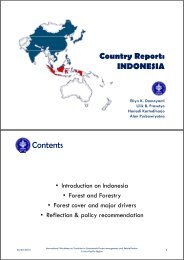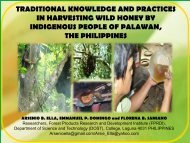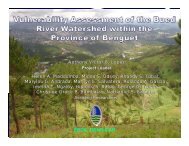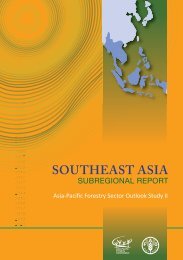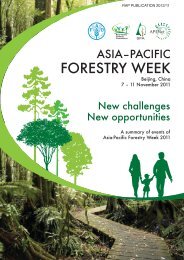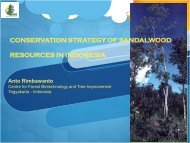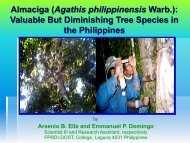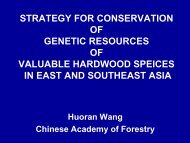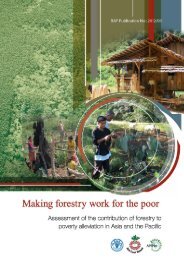ภาพนิ่ง 1
ภาพนิ่ง 1
ภาพนิ่ง 1
Create successful ePaper yourself
Turn your PDF publications into a flip-book with our unique Google optimized e-Paper software.
Chloroplast DNA phylogeography<br />
of Dalbergia cochinchinensis<br />
Pierre in Thailand and Laos<br />
Ratree Yooyuen<br />
Sutee Duangjai<br />
1,2<br />
Suchitra Changtragoon<br />
1<br />
2<br />
1<br />
Department of Forest Biology, Faculty of<br />
Forestry, Kasetsart University, Thailand<br />
2 Department of Nation Park, Wildlife and<br />
Plant Conservation, Thailand
Dalbergia cochinchinensis Pierre<br />
• Thai name : Phayung (Siamense rosewood)<br />
• Distribution : Laos, Cambodia, Vietnam, Myanmar<br />
and Thailand<br />
• Thailand : Central, East and Northeast<br />
• Ecology : In mixed deciduous and dry evergreen<br />
forest, 50-200 msl.
Important and Problems<br />
• Very high demanded in Thailand and Asian region<br />
• Illegal logging affect to gene pool, genetic diversity<br />
and structure<br />
• No data of molecular genetic<br />
• No tools to verify the origin of wood
Objective<br />
Investigated the cpDNA phylogeography of D.<br />
cochinchinensis by using DNA sequencing to<br />
characterize the spatial genetic variation and pattern<br />
of haplotypes of investigated populations in Thailand<br />
and Laos
DNA in plant cells<br />
• Nucleus (nDNA)<br />
• Mitochondria (mtDNA)<br />
• Chloroplast (cpDNA)<br />
Source : http://www.nature.com/nbt/journal/v21/n4/fig_tab/nbt0403-374_F1.html<br />
Variation patterns of maternally inherited cpDNA haplotypes<br />
are often suitable for distinguish the origin of trees
Chloroplast genome in angiosperm<br />
• Circular DNA molecule<br />
• 120-160 Kb<br />
• About 120 genes<br />
• LSC, SSC, IR<br />
Non coding region<br />
• Intron<br />
• Intergenic spacer<br />
Source : http://www.biomedcentral.com/1471-2164/7/61/figure/F1?highres=y
DNA markers<br />
Hybridization<br />
• Restriction Fragment Length Polymorphism (RFLP)<br />
Polymerase Chain Reaction<br />
• Random Amplified Polymorphic DNA (RAPD)<br />
• Amplified Fragment Length Polymorphism (AFLP)<br />
• Microsatellite marker (SSR)<br />
• Single Nucleotide Polymorphism (SNP)<br />
Chloroplast DNA markers can be used to investigate<br />
DNA variation and pattern of haplotypes among<br />
different populations
Another research of phylogeography for<br />
distinguish the origin of trees<br />
• Chloroplast DNA variation in European white oaks<br />
Phylogeography and patterns of diversity based on data<br />
from over 2600 populations (Petit et al., 2002)<br />
• Checking the origin of oak wood: molecular and<br />
statistical tools (Deguilloux et al., 2003)<br />
• Postglacial migration shaped the variation of cpDNA of<br />
numerous woody species in Central and Northern Europe<br />
(Petit et al., 2003)<br />
• DNA-based control of oak wood geographic origin in the<br />
context of the cooperage industry (Deguilloux et al., 2004)
Methodology<br />
Populations for study<br />
Vientiane,<br />
Laos (VL)<br />
Ponpisai,<br />
Nong Khai (PN)<br />
Phu Pha Lek,<br />
Sakon Nakhon (PS)<br />
Chuen Chom,<br />
Maha Sarakham (CM)<br />
Phu Pha Thoep,<br />
Mukdahan (PM)<br />
Phu Laenkha,<br />
Chaiyaphum (PC)<br />
Muakleknai,<br />
Saraburi (MS)<br />
Na Dun,<br />
Maha Sarakam (NM)<br />
Tapraya,<br />
Buriram (TB)<br />
Dongnatam, Ubon<br />
Ratchathani (DU)<br />
10-12 samples<br />
per population<br />
MS, PM, PS, PC and TB : National Park<br />
CM, PN and VL : Conserved forest<br />
NM : Community forest<br />
DU : Community forest and part of National Park
Methodology<br />
Regions of chloroplast genome studied
Methodology<br />
Leaves or barks<br />
DNA extraction<br />
Genomic DNA<br />
Primers<br />
• trnC-petN1R<br />
• trnS-trnG<br />
• trnV-trnM<br />
Polymerase chain reactions (PCR)
Methodology<br />
PCR products<br />
Direct sequencing<br />
Data analysis<br />
• Sequences were aligned and edited by using Bioedit<br />
version 7.0.5.3 software<br />
• Haplotype diversity (h), DnaSP version 5.10.01 software<br />
• Identify groups of populations (higher F CT values) with<br />
1,000 permutations, Arlequin version 3.5.1.2 software
Results and Discussion<br />
Regions revealed polymorphisms<br />
trnS-trnG (size ≈ 600 bp)<br />
trnV-trnM (size ≈ 900 bp)<br />
trnC-petN1R (size ≈ 1,000 bp)<br />
trnS-trnG trnV-trnM trnC-petN1R
Results and Discussion<br />
haplotypes<br />
Polymorphic sites and cpDNA haplotypes based on<br />
sequences of the trnS-trnG, trnV-trnM and trnC-petN1R.<br />
trnS-trnG<br />
trnV-trnM<br />
trnC-petN1R<br />
SNP<br />
SNP SNP InDel a InDel b SNP SNP SNP SNP SNP<br />
1 3 4 1 2 6 2 3 7 7<br />
3 8 1 2 5 2 0 9 0 0<br />
Populations<br />
6 7 2 8 8 1 6 0 1 2 MS VL DU PM PN CM NM PS TB PC Total<br />
H1 T T G 6 bp 5 bp A T T C T 10 5 6 6 8 5 11 6 9 66<br />
H2 G · · 6 bp 5 bp · · · · · 5 1 6<br />
H3 · C · 6 bp 5 bp · · · · · 2 2<br />
H4 · C A 6 bp 5 bp · · · · · 1 1<br />
H5 · · · - - · · · · · 8 8<br />
H6 · · · - 5 bp · · G · · 5 4 9<br />
H7 · · · - 5 bp · · · · · 1 1<br />
H8 · · · 6 bp 5 bp · G · · · 1 1<br />
H9 · · · 6 bp 5 bp · · · . G 5 4 9<br />
H10 · · · 6 bp 5 bp C · · · · 2 2<br />
H11 · · · 6 bp 5 bp · · · T . 3 3<br />
Total 10 10 10 11 10 11 12 11 11 12 108<br />
a<br />
Deletion of ACAATC<br />
b<br />
Deletion of AGTAT
Results and Discussion<br />
Molecular diversity indexes of D. cochinchinensis<br />
Populations<br />
Samples<br />
size<br />
Latitude-Longitude<br />
(N-E)<br />
Number of<br />
Haplotypes<br />
Haplotype<br />
diversity(h)<br />
Muakleknai, Saraburi (MS)<br />
Vientiane, Laos (VL)<br />
Dongnatam, Ubon Ratchathani (DU)<br />
Phu Pha Thoep, Mukdahan (PM)<br />
Ponpisai, Nong Khai (PN)<br />
Chuen Chom, Maha Sarakham (CM)<br />
Na Dun, Maha Sarakam (NM)<br />
Phu Pha Lek, Sakon Nakhon (PS)<br />
Phu Laenkha, Chaiyaphum (PC)<br />
Tapraya, Buriram (TB)<br />
10<br />
10<br />
10<br />
11<br />
10<br />
11<br />
12<br />
11<br />
12<br />
11<br />
144119N 1011142E<br />
175800N 1023600E<br />
153704N 1053717E<br />
164236N 1044517E<br />
180119N 1030438E<br />
163153N 1031018E<br />
154235N 1031347E<br />
171628N 1032655E<br />
160027N 1015341E<br />
171007N 1023456E<br />
2<br />
1<br />
2<br />
2<br />
2<br />
3<br />
4<br />
1<br />
2<br />
3<br />
0.356<br />
0.000<br />
0.556<br />
0.546<br />
0.533<br />
0.473<br />
0.697<br />
0.000<br />
0.409<br />
0.618<br />
Total 108 11 0.608<br />
Na Dun population in Maha Sarakam province (NM) is<br />
the community forest which has been reforested by<br />
the different sources of D. cochinchinensis materials
Results and Discussion<br />
Distribution range, categorized into 2 main geographical groups<br />
VL<br />
PN<br />
F CT = 0.74<br />
MS<br />
PC<br />
TB<br />
NM<br />
CM<br />
PS<br />
PM<br />
DU<br />
H1<br />
H2<br />
H3<br />
H4<br />
H5<br />
H6<br />
H7<br />
H8<br />
H9<br />
H10<br />
H11
Results and Discussion<br />
Some populations have unique haplotypes<br />
VL<br />
PN<br />
PS<br />
PC<br />
CM<br />
PM<br />
NM<br />
DU<br />
MS<br />
TB
Conclusion and suggestion<br />
• trnS-trnG, trnV-trnM and trnC-petN1R, these cpDNA<br />
markers could be used as a tools to characterize<br />
variation and pattern of haplotypes of D.<br />
cochinchinensis<br />
• Distribution range, the samples were categorized<br />
into 2 main geographical groups (FCT=0.74), the first<br />
group was the large area in the northeast of Thailand<br />
(including Laos) and the second group is a small<br />
population, Muakleknai in Saraburi province (MS) in<br />
the central part of Thailand
Conclusion and suggestion<br />
• Unique haplotype of the certain mentioned<br />
populations could be use as a tool to identify the<br />
origin of illegally logged woods in the future<br />
• More molecular markers, number of samples and<br />
populations of D.cochinchinensis in Thailand and<br />
Asian region should be collected and investigated for<br />
the indicative haplotype for specific populations,<br />
subregion and countries
Acknowledgements<br />
• Department of National Park, Wildlife and Plant Conservation<br />
for providing financial support and DNA laboratory facility<br />
• Graduate School, Kasetsart University for providing fund for<br />
research to publish in the international journal<br />
• Dr. Chadaporn Senakun, Mr. Sanguen Wongsa and Dr. Suwan<br />
Tangmitcharoen<br />
• Assistant researchers at Forest Genetics and Biotechnology<br />
Division, Forest and Plant Conservation Research office,<br />
Department of National Park, Wildlife and Plant Conservation




